Fire-Resistance Testing Procedures for Construction Elements—A Review
Abstract
:1. Introduction
2. Methodology
2.1. Aim and Objectives
- A comparison of different fire-resistance testing standards based on methods of testing, furnace design, specimen size, etc.
- A comparison of performance criteria of different fire-resistance test standards.
- A summary of limitations of different fire-resistance test standards.
- A literature review on fire-resistance testing on building and construction materials.
- A summary of selected full-scale, ad hoc, and specialized setups based on their unique testing procedures reported in the literature.
2.2. Structure of the Review
3. Fire-Resistance Test Standards
3.1. Types of Furnaces in Different Fire-Resistance Test Standards
3.2. Specimen Size in Different Fire-Resistance Test Standards
3.3. Test Procedures in Different Fire-Resistance Test Standards
3.4. Performance Criterion in Different Fire-Resistance Test Standards
3.5. Limitation in Different Fire-Resistance Test Standards
4. Fire-Resistance Furnaces
| S. No. | Furnace | Specifications | Schematics | Ref. | |
|---|---|---|---|---|---|
| 1. | Large horizontal-structure-type furnace | Size | 6 m × 5 m × 1.5 m |  | [26] |
| Fire curve follows | ISO 834 | ||||
| Duration of heating phase | 150 min and 160 min | ||||
| 2. | Vertical fire test furnace | Size | Width top beam: 406.4 mm Width bottom beam: 304.8 mm |  | [27] |
| Standard | ASTM E119 | ||||
| Duration of heating phase | 90 min | ||||
| 3. | Structural fire testing furnace | Size | Hight of all four columns: 1.7 m | 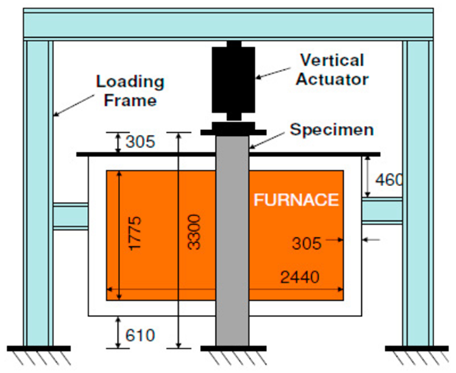 | [28] |
| Standard | ASTM E119 | ||||
| Duration of heating phase | 90 min and 120 min | ||||
| 4. | Column fire furnace | Size | Internal hot zone: 2 m × 1 m × 1 m | 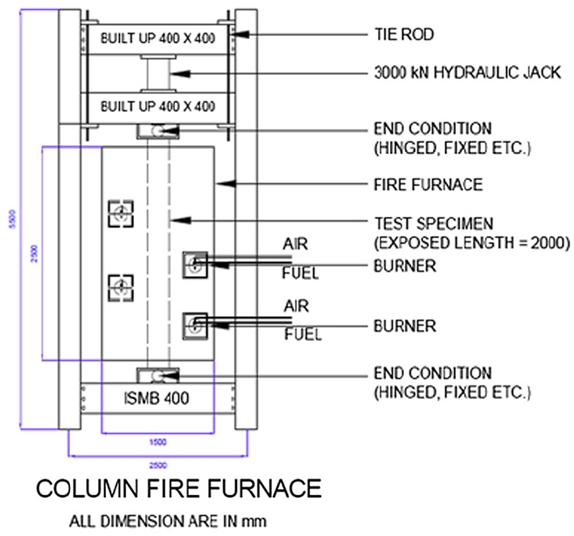 | [29] |
| 5. | Small-scale fireproof testing furnace | Fire curve follows | ISO 834 | 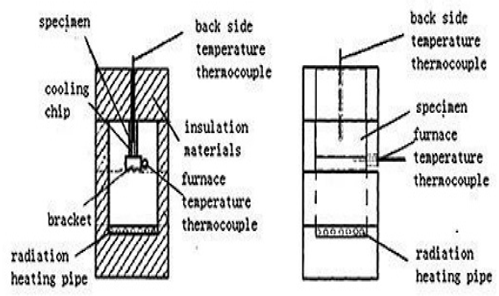 | [30] |
| 6. | Vulcan fire-resistance test furnace | Size | 0.5 m × 0.5 m × 0.5 m | 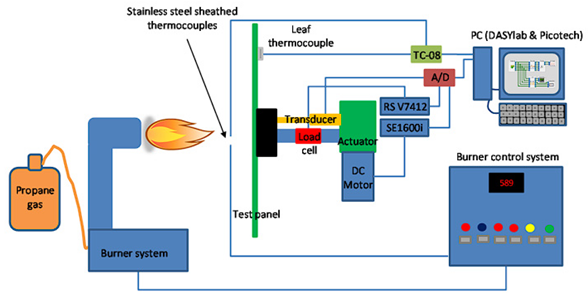 | [31] |
| Standard | BS 476 | ||||
| 7. | Large-scale furnace | Fire curve follows | ISO 834 | 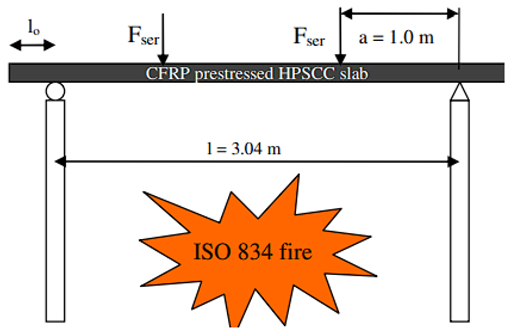 | [32] |
| 8. | Large-size furnace | Max furnace temp. | 1300 °C | 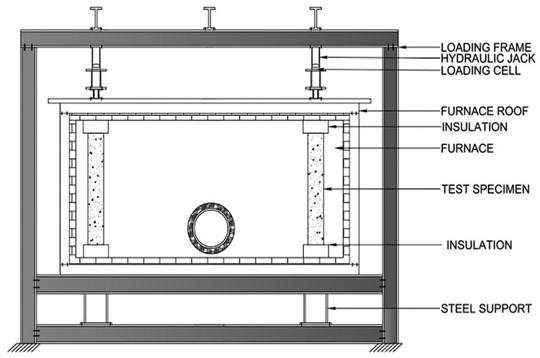 | [33] |
| 9. | Custom-designed fire-resistance test furnace | Fire curve follows | ISO 834 |  | [34] |
| 10. | Fire test furnace | Standard | CAN/ULC-S101-14 |  | [35] |
| 11. | Horizontal fire test furnace | Size | 5 m × 3 m | 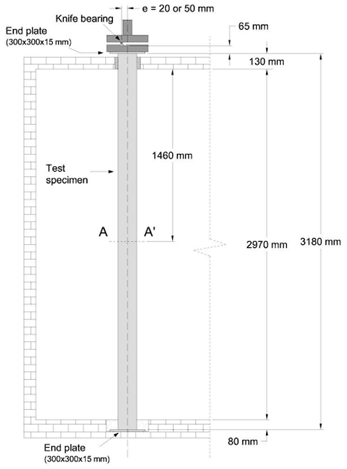 | [36] |
| Fire curve follows | ISO 834 | ||||
| 12. | Large-scale vertical fire-resistance test furnace | Size | Internal chamber: 3 m × 3 m × 1.3 m | 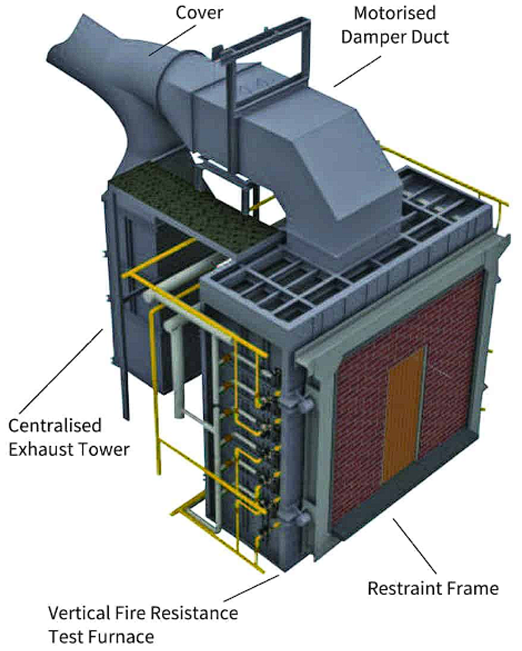 | [37] |
| Standard | BS476 Parts 20–24 EN1363 | ||||
| 13. | Horizontal fire-resistance test furnace | Size | Internal chamber: 3 m × 4 m × 1 m | 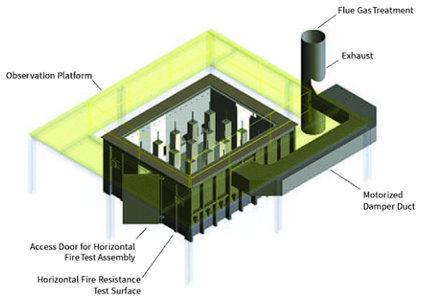 | [37] |
| Standards | BS476 Parts 20–24 EN1363 | ||||
| 14. | Indicative fire-resistance test furnace | Size | Internal chamber: 1 m × 1 m × 1 m, and 1.5 m × 1.5 m × 1.5 m |  | [39] |
| 15. | Large structural fire test furnace | Standards | AS1530.4, BS476 Parts 20–24, ISO 834, ISO 3008, ISO 3009, and ASTM E119 | 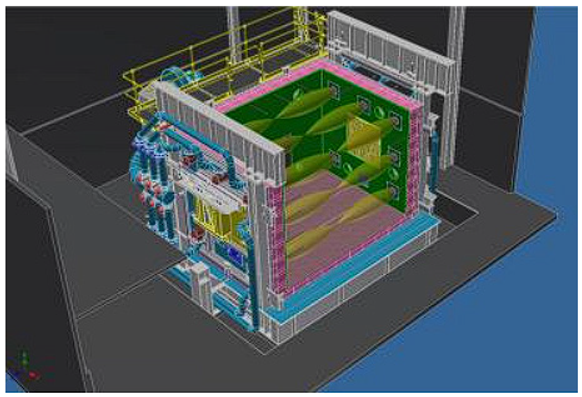 | [40] |
5. Non-Standard/Ad Hoc Fire-Resistance Testing Setup Used by Researchers
6. Concluding Remarks
Author Contributions
Funding
Institutional Review Board Statement
Informed Consent Statement
Data Availability Statement
Acknowledgments
Conflicts of Interest
References
- India-Risk-Survey-2017-Report. Available online: https://ficci.in/Sedocument/20416/India-Risk-Survey-2017-Report.pdf (accessed on 14 July 2022).
- India-Risk-Survey-2018. Available online: https://ficci.in/Sedocument/20450/India%20Risk%20Survey%20-%202018.pdf (accessed on 14 July 2022).
- Ahrens, M. Fire Loss in the United States during 2020. Available online: https://www.maine.gov/dps/fmo/sites/maine.gov.dps.fmo/files/inline-files/Fire%20Loss%20in%20the%20US%20during%202020.pdf (accessed on 14 July 2022).
- Beyler, C.; Beitel, J.; Iwankiw, N.; Lattimer, B. Fire Resistance Testing for Performance-Based Fire Design of Buildings; Final Report, NIST GCR 07-910; National Institute of Standards and Technology, U.S. Department of Commerce: Washington, DC, USA, 2007.
- Babrauskas, V.; Williamson, R.B. The historical basis of fire resistance testing—Part I. Fire Technol. 1978, 14, 184–194. [Google Scholar] [CrossRef]
- Babrauskas, V.; Williamson, R.B. The historical basis of fire resistance testing—Part II. Fire Technol. 1978, 14, 304–316. [Google Scholar] [CrossRef]
- Bisby, L.; Gales, J.; Maluk, C. A contemporary review of large-scale non-standard structural fire testing. Fire Sci. Rev. 2013, 2, 1. [Google Scholar] [CrossRef] [Green Version]
- Roszkowski, P.; Kimbar, G. Full-scale external fire test of free-standing steel silo. Fire Saf. J. 2021, 120, 103123. [Google Scholar] [CrossRef]
- Jiang, S.; Zhu, S.; Guo, X.; Li, Z. Full-scale fire tests on steel roof truss structures. J. Constr. Steel Res. 2020, 169, 106025. [Google Scholar] [CrossRef]
- Shah, A.H.; Sharma, U.K.; Bhargava, P. Outcomes of a major research on full scale testing of RC frames in post earthquake fire. Constr. Build. Mater. 2017, 155, 1224–1241. [Google Scholar] [CrossRef]
- Zheng, W.Z.; Hou, X.M.; Shi, D.S.; Xu, M.X. Experimental study on concrete spalling in prestressed slabs subjected to fire. Fire Saf. J. 2010, 45, 283–297. [Google Scholar] [CrossRef]
- Vedrtnam, A.; Bedon, C.; Youssef, M.A.; Wamiq, M.; Sabsabi, A.; Chaturvedi, S. Experimental and numerical structural assessment of transparent and tinted glass during fire exposure. Constr. Build. Mater. 2020, 250, 118918. [Google Scholar] [CrossRef]
- ASTM E119: Standard Test Methods for Fire Tests of Building Construction and Materials. Available online: https://technokontrol.com/pdf/walls_astm.e119.2000.pdf (accessed on 28 December 2021).
- AS 1530.4-2005 Methods for Fire Tests on Building Materials, Components and Structures. Part 4: Fire-Resistance Test of Elements of Construction | Building CodeHub. Available online: https://codehub.building.govt.nz/resources/as-1530-4-2005/ (accessed on 2 November 2021).
- British Standard 476 Fire Tests: Firesafe.org.uk. Available online: https://www.firesafe.org.uk/british-standard-476-fire-tests/ (accessed on 2 November 2021).
- IS 3809; Fire Resistance Test for Structures. Bureau of Indian Standards: New Delhi, India, 1979. Available online: https://ia800900.us.archive.org/9/items/gov.in.is.3809.1979/is.3809.1979.pdf (accessed on 28 December 2021).
- Fire Resistance Test to Building Construction—CASfire. Available online: http://www.casfire.cn/en/?stm_works=fire-test-to-building-material (accessed on 28 December 2021).
- DIN4102-1: Fire Test to Building Material–Classification_Building Material_Fire Test Center_FireTC.net. Available online: http://www.firetc.net/firetesting/show.php?itemid=663 (accessed on 2 November 2021).
- Japan Standards Association (JSA). JIS A 1304: Method of Fire Resistance Test for Structural Parts of Buildings. 1994. Available online: http://archive.org/details/jis.a.1304.e.1994 (accessed on 28 December 2021).
- EN 1363-1 Fire Resistance Test_Test Method_Fire Test Center_FireTC.net. Available online: http://firetc.net/firetesting/show.php?itemid=720 (accessed on 2 November 2021).
- ISO 834-13:2019. Available online: https://www.iso.org/standard/66439.html (accessed on 28 December 2021).
- Fire Resistance Test Furnace, Fire Resistance Test Furnace & Fire Test Apparatus—CMTS. Available online: https://www.cmtsproduct.com/fire-resistance-test-furnace/ (accessed on 2 November 2021).
- Chow, W.K. Review on fire safety management and application to Hong Kong. Int. J. Eng. Perform.-Based Fire Codes 2001, 3, 52–58. [Google Scholar]
- Fire Performance and Flammability of Materials, Specifying Fielders. Available online: https://specifying.fielders.com.au/roofing-walling/design-data/fire-performance-and-flammability-of-materials/ (accessed on 12 December 2021).
- Dumont, F.; Wellens, E.; Gernay, T.; Franssen, J.-M. Loadbearing capacity criteria in fire resistance testing. Mater. Struct. 2016, 49, 4565–4581. [Google Scholar] [CrossRef] [Green Version]
- Kai, Y.; Yao, Z.; Hao, C.; Lili, F.; Zhang, X. Postfire Safety Investigation on Prestressed RPC Beams after Exposure to Elevated Temperatures. Adv. Mater. Sci. Eng. 2020, 2020, e7837418. [Google Scholar] [CrossRef]
- Imani, R.; Mosqueda, G.; Bruneau, M. Experimental Study on Post-Earthquake Fire Resistance of Ductile Concrete-Filled Double-Skin Tube Columns. J. Struct. Eng. 2014, 141, 04014192. [Google Scholar] [CrossRef] [Green Version]
- Kodur, V.; Hibner, D.; Agrawal, A. Residual response of reinforced concrete columns exposed to design fires. Procedia Eng. 2017, 210, 574–581. [Google Scholar] [CrossRef]
- Shah, A.H.; Sharma, U.K. Fire resistance and spalling performance of confined concrete columns. Constr. Build. Mater. 2017, 156, 161–174. [Google Scholar] [CrossRef]
- Ji, W.; Hua, S.; Miao, Z.; Zhen, C. Study and Prediction for the Fire Resistance of Acid Corroded Intumescent Coating. Procedia Eng. 2014, 84, 524–534. [Google Scholar] [CrossRef] [Green Version]
- Cutter, P.A.; Shenoi, R.; Phillips, H.; Moy, S.S.J. A new small scale fire resistance test method for composite materials. In Proceedings of the International Conferences on Composite Materials (ICCM), Edinburgh, UK, 27–31 July 2009. [Google Scholar]
- Maluk, C.; Terrasi, G.; Bisby, L.; Stutz, A.; Hugi, E. Experimental fire Behaviour of Thin-walled CFRP Pretensioned High Strength Concrete Slabs under Service Load. In Proceedings of the 7th International Conference on FRP Composites in Civil Engineering (CICE), Vancouver, BC, Canada, 20–22 August 2014. [Google Scholar]
- Nair, A.; Salem, S. Experimental Determination of the Residual Compressive Strength of Concrete Columns Subjected to Different Fire Durations and Load Ratios. J. Struct. Fire Eng. 2020, 11, 529–543. [Google Scholar] [CrossRef]
- Lineham, S.; Thomson, D.; Bartlett, A.; Bisby, L.; Hadden, R. Structural response of fire-exposed cross-laminated timber beams under sustained loads. Fire Saf. J. 2016, 85, 23–34. [Google Scholar] [CrossRef]
- Salem, S. Parametric Study on Load Ratio Effect on the Flexural Bending Behaviour of Axially-restrained HSS Steel Beams Subjected to Fire. J. Struct. Fire Eng. 2018, 9, 342–360. [Google Scholar] [CrossRef]
- Moliner, V.; Espinós, A.; Romero, M.; Hospitaler, A. Fire behavior of eccentrically loaded slender high strength concrete-filled tubular columns. J. Construct. Steel Res. 2013, 83, 137. [Google Scholar] [CrossRef]
- Large Scale Vertical Fire Resistance Test Furnace—Fire Testing Technology. Available online: https://www.cmtsproduct.com/vertical-fire-resistance-test-furnace/ (accessed on 19 January 2022).
- Horizontal Fire Resistance Test Furnace—Fire Testing Technology. Available online: https://www.fire-testing.com/horizontal-fire-resistance-test-furnace/ (accessed on 19 January 2022).
- Indicative Fire Resistance Test Furnace—Fire Testing Technology. Available online: https://www.fire-testing.com/indicative-fire-resistance-test-furnace/ (accessed on 19 January 2022).
- Fire Test Facilities, Victoria University, Australia. Available online: https://www.vu.edu.au/research/researching-at-vu/laboratories-facilities/fire-test-facilities (accessed on 14 October 2022).
- Wickström, U. The plate thermometer—A simple instrument for reaching harmonized fire resistance tests. Fire Technol. 1994, 30, 195–208. [Google Scholar] [CrossRef]
- Han, H.-S.; Yun, H.-S.; Hwang, C.-H. Calibration of the plate thermometer for measuring heat flux using a conical heater. J. Mech. Sci. Technol. 2019, 33, 3563–3569. [Google Scholar] [CrossRef]
- Ingason, H.; Wickström, U. Measuring incident radiant heat flux using the plate thermometer. Fire Saf. J. 2007, 42, 161–166. [Google Scholar] [CrossRef]
- Sultan, M.A. Fire Resistance Furnace Temperature Measurements: Plate Thermometers vs. Shielded Thermocouples. Fire Technol. 2006, 42, 253–267. [Google Scholar] [CrossRef] [Green Version]
- Ditch, B. Evaluating Pool Fire Severity and the Cooling Effect of Local Water Spray Using a Continuous Plate Thermometer. Fire Saf. Sci. 2011, 10, 133–144. [Google Scholar] [CrossRef]
- Sultan, M. Comparisons of Temperature and Heat Flux in Furnaces Controlled by Different Types of Temperature Sensors. J. ASTM Int. 2010, 7, 44–62. [Google Scholar] [CrossRef] [Green Version]
- Ramírez, C.P.; Barriguete, A.V.; Somolinos, R.S.; del Río Merino, M.; Atanes Sánchez, E. Analysis of fire resistance of cement mortars with mineral wool from recycling. Constr. Build. Mater. 2020, 265, 120349. [Google Scholar] [CrossRef]
- Štefan, R.; Foglar, M.; Fládr, J.; Horníková, K.; Holan, J. Thermal, spalling, and mechanical behaviour of various types of cementitious composites exposed to fire: Experimental and numerical analysis. Constr. Build. Mater. 2020, 262, 119676. [Google Scholar] [CrossRef]
- Sarker, P.K.; Mcbeath, S. Fire endurance of steel reinforced fly ash geopolymer concrete elements. Constr. Build. Mater. 2015, 90, 91–98. [Google Scholar] [CrossRef]
- Chen, B.; Zhu, H.; Li, B.; Sham, M.; Li, Z. Study on the fire resistance performance of cementitious composites containing recycled glass cullets (RGCs). Constr. Build. Mater. 2020, 242, 117992. [Google Scholar] [CrossRef]
- Maier, M.; Zeiml, M.; Lackner, R. On the effect of pore-space properties and water saturation on explosive spalling of fire-loaded concrete. Constr. Build. Mater. 2020, 231, 117150. [Google Scholar] [CrossRef]
- Park, J.; Kwark, J. Experimental Study on Fire Sources for Full-Scale Fire Testing of Simple Sprinkler Systems Installed in Multiplexes. Fire 2021, 4, 8. [Google Scholar] [CrossRef]
- Lafrance, P.-S.; Berzins, R.; Leroux, P.; Su, J.Z.; Lougheed, G.D. Full-Scale Standard Fire Resistance Test of a Wall Assembly for Use in Lower Storeys of Mid-Rise Buildings: Report to Research Consortium for Wood and Wood-Hybrid Mid-Rise Buildings; National Research Council of Canada: Ottawa, ON, Canada, 2014. [CrossRef]
- Sultan, M.; Benichou, N.; Min, B. Heat exposure in fire resistance furnaces: Full-scale vs. intermediate-scale. In Proceedings of the Fire and Materials 2003 International Conference, San Francisco, CA, USA, 27–29 January 2003; pp. 43–53. [Google Scholar]
- Nassif, A.Y.; Yoshitake, I.; Allam, A. Full-scale fire testing and numerical modelling of the transient thermo-mechanical behaviour of steel-stud gypsum board partition walls. Constr. Build. Mater. 2014, 59, 51–61. [Google Scholar] [CrossRef]
- Hidalgo, J.P.; Cowlard, A.; Abecassis-Empis, C.; Maluk, C.; Majdalani, A.H.; Kahrmann, S.; Hilditch, R.; Krajcovic, M.; Torero, J.L. An experimental study of full-scale open floor plan enclosure fires. Fire Saf. J. 2017, 89, 22–40. [Google Scholar] [CrossRef]
- Gales, J.; Maluk, C.; Bisby, L. Structural Fire Testing—Where are we, how did we get here, and where are we going? In Proceedings of the 15th International Conference on Experimental Mechanics (ICEM 15), Porto, Portugal, 22–27 July 2012. [Google Scholar]
- Zhang, C.; Grosshandler, W.; Sauca, A.; Choe, L. Design of an ASTM E119 fire environment in a large compartment. Fire Technol. 2019, 56, 1155–1177. [Google Scholar] [CrossRef] [PubMed]
- Rodrigues, J.P.; Laím, L.; Gonçalves, M. Fire resistance of square and circular cross-section concrete columns. In Proceedings of the 7th International Conference on Structures in Fire, Zurich, Switzerland, 6–8 June 2012. [Google Scholar]
- Magarabooshanam, H.; Ariyanayagam, A.; Mahendran, M. Behaviour of load bearing double stud LSF walls in fire. Fire Saf. J. 2019, 107, 15–28. [Google Scholar] [CrossRef]

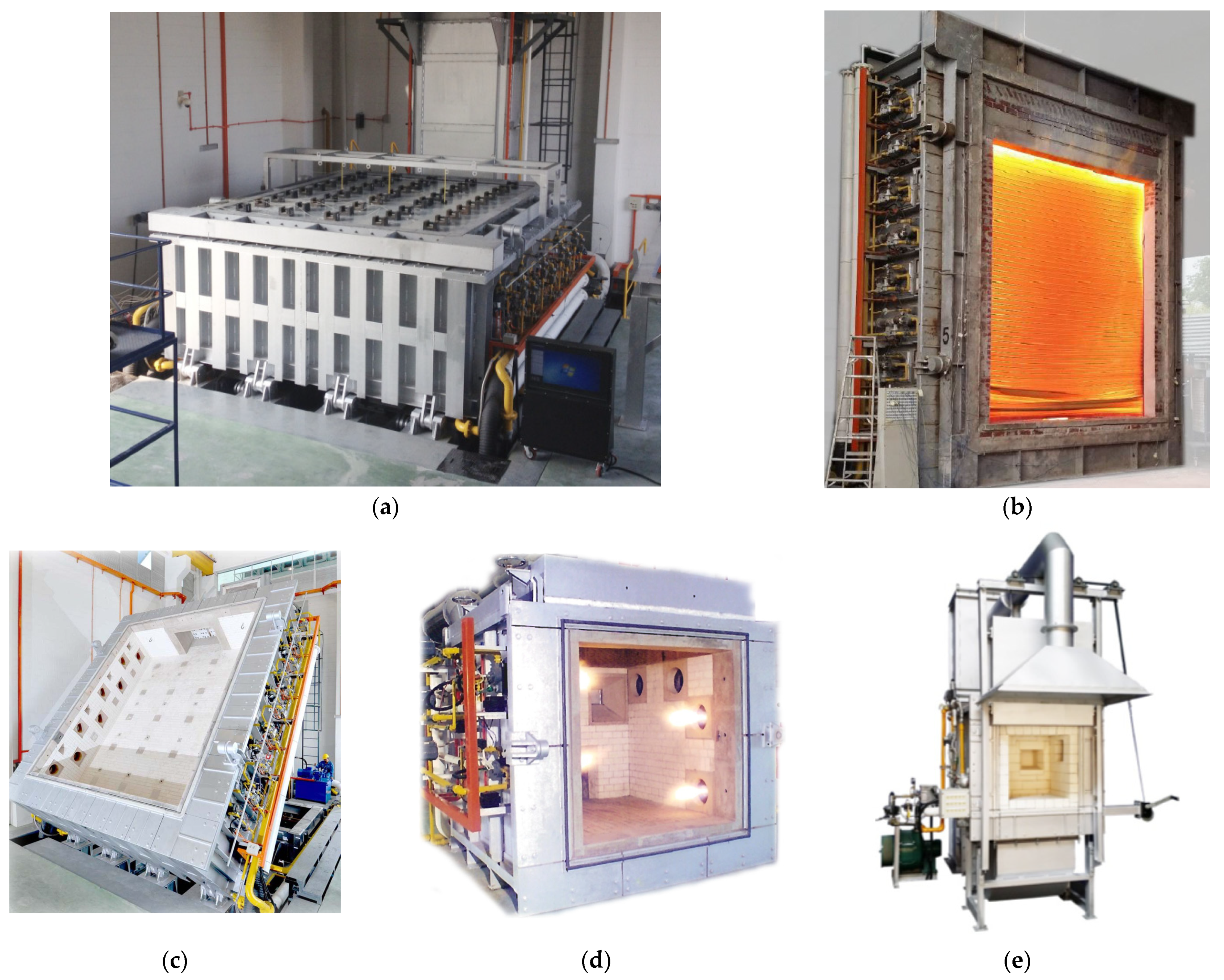
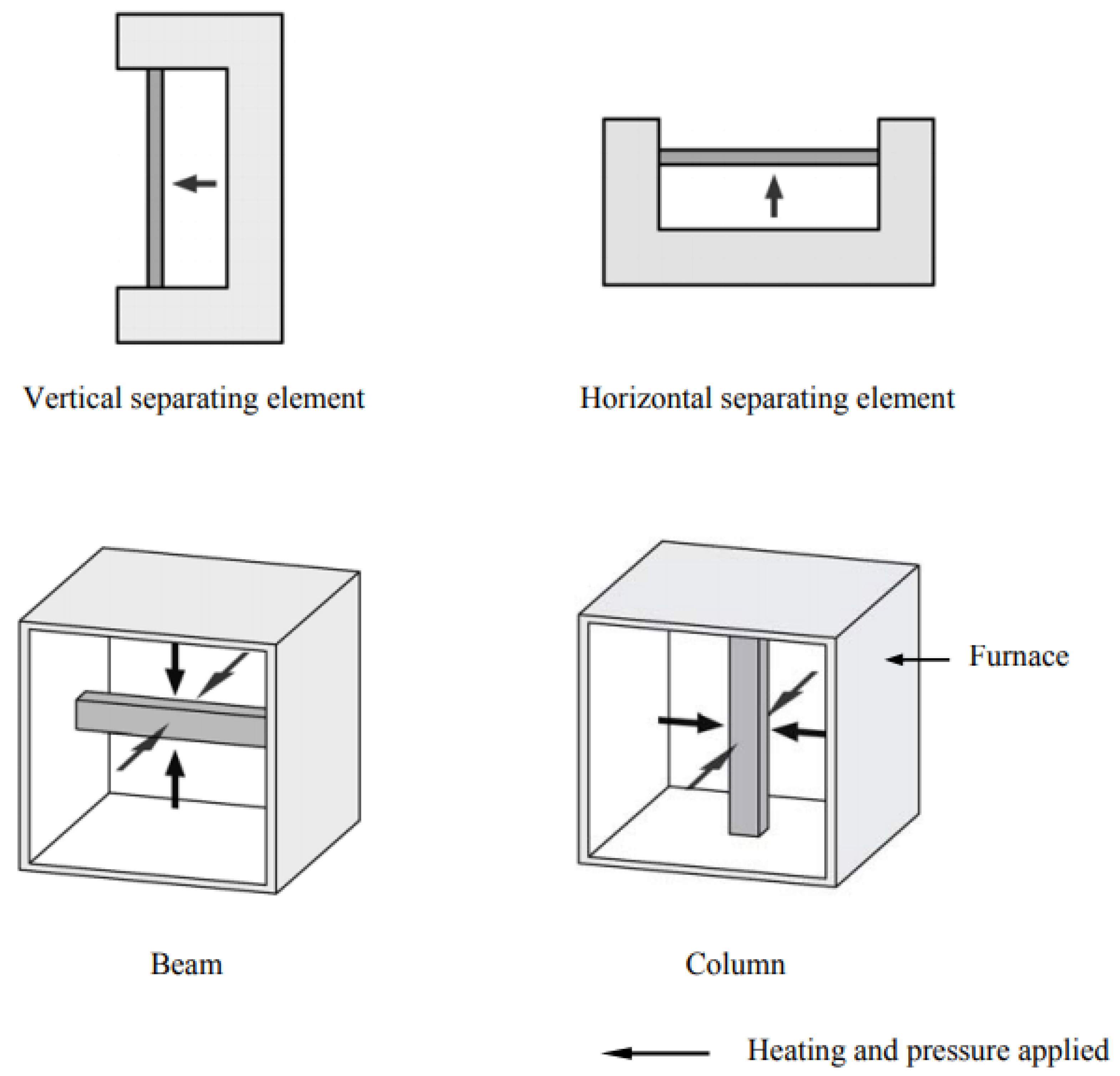

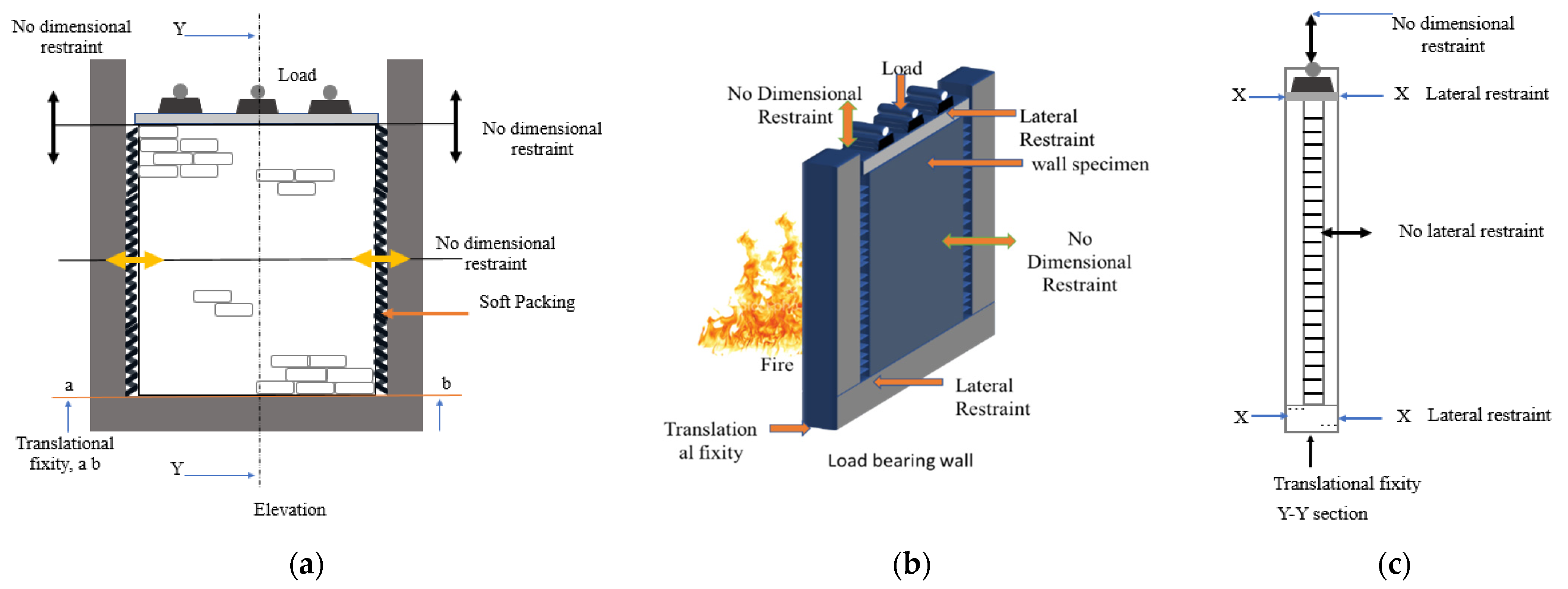

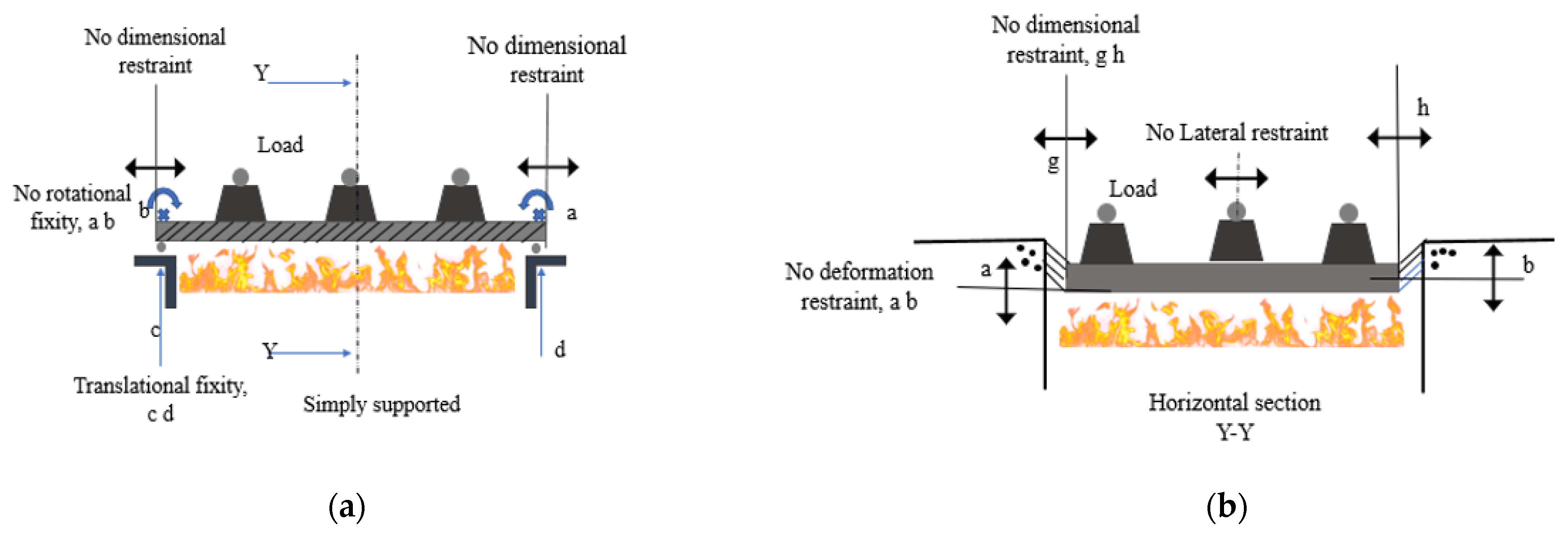

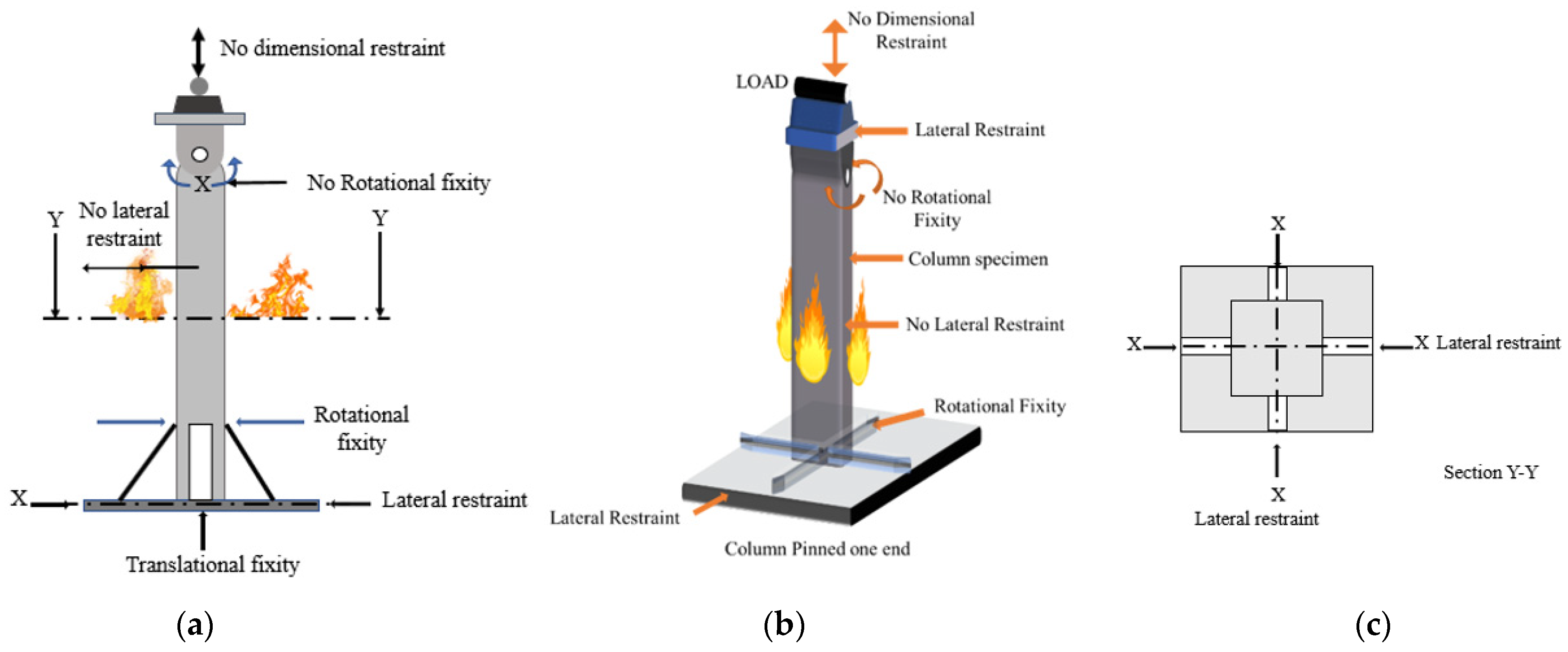

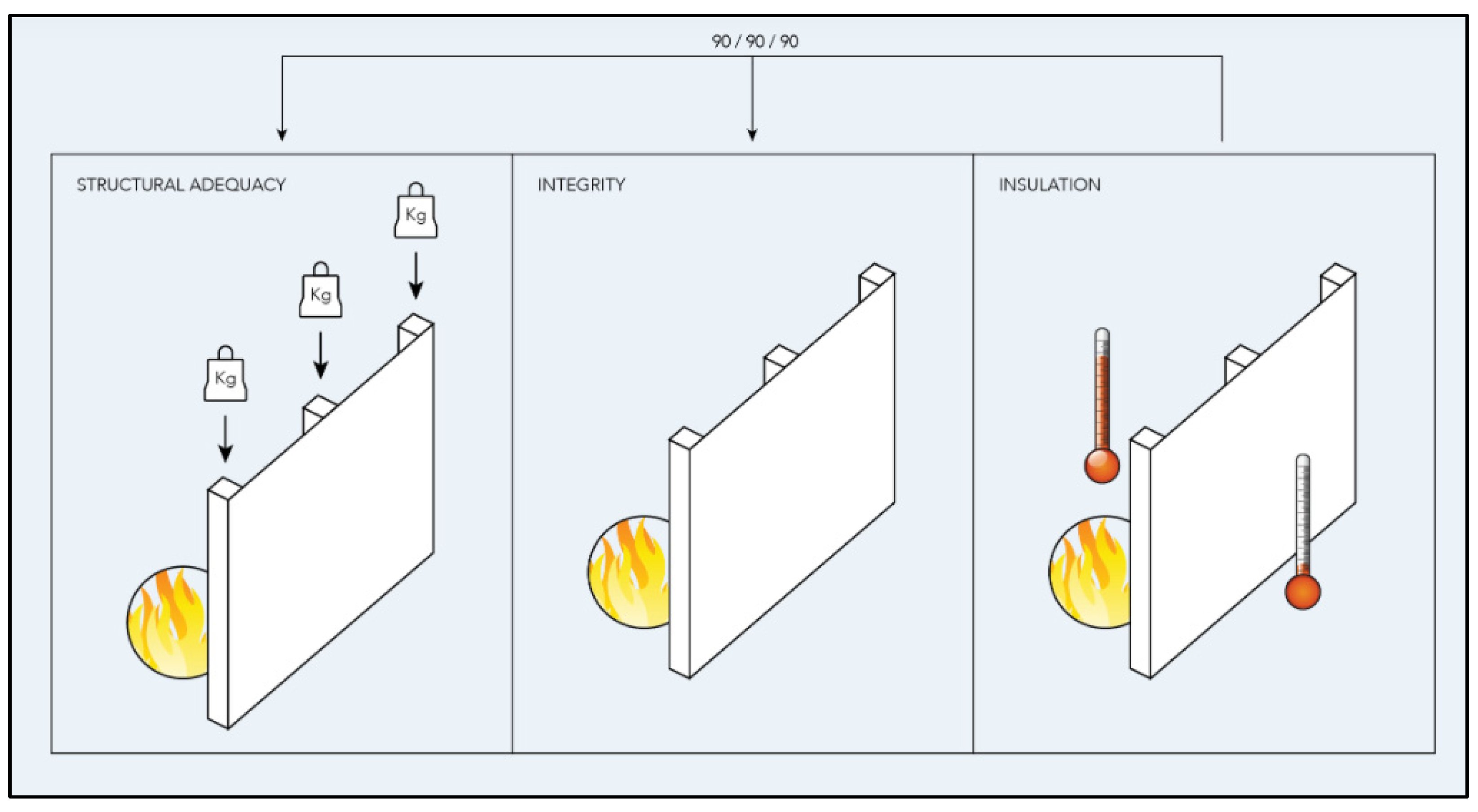
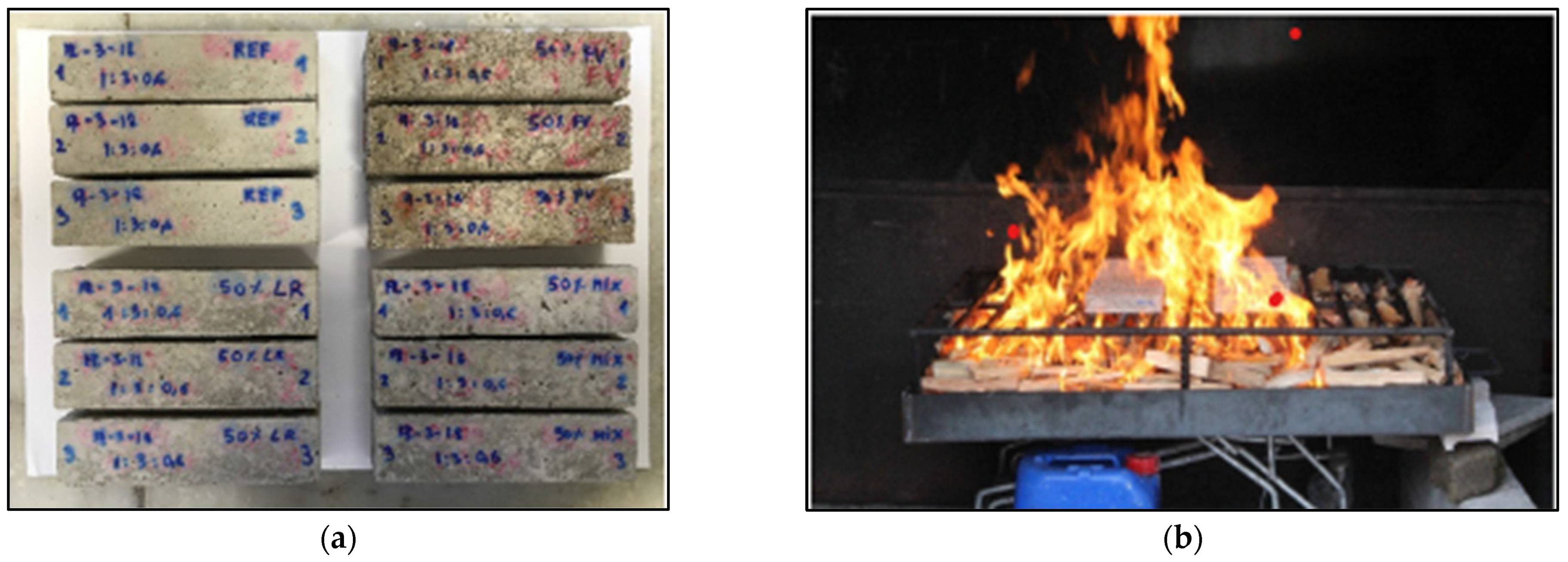




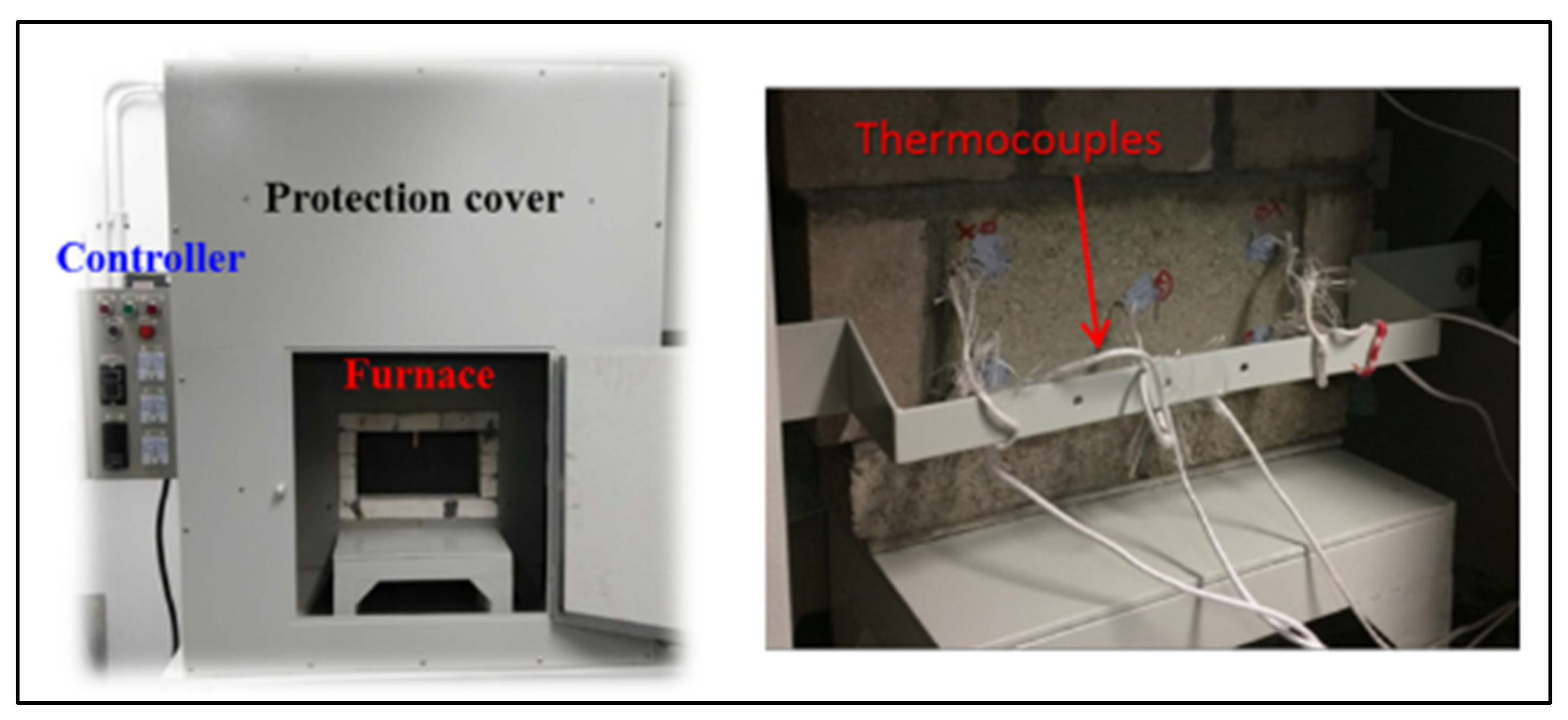
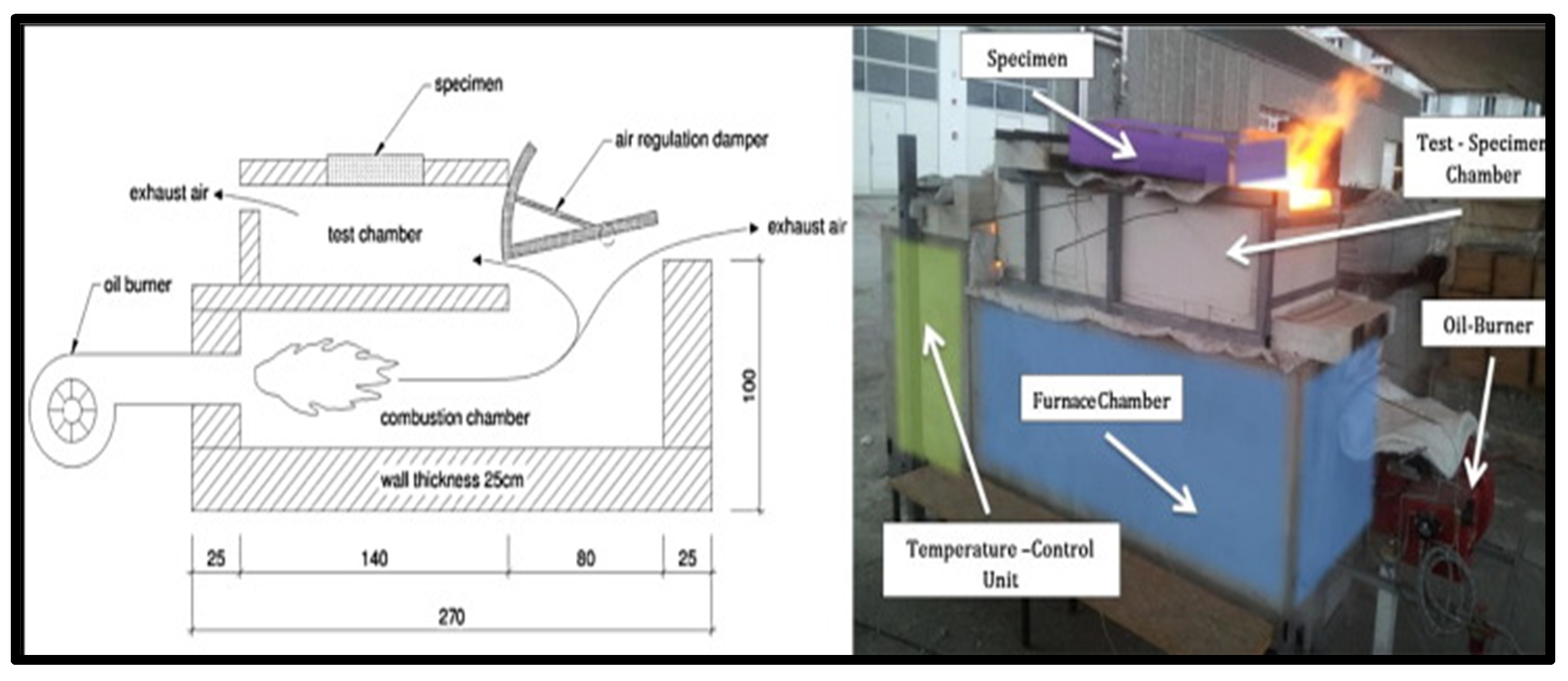
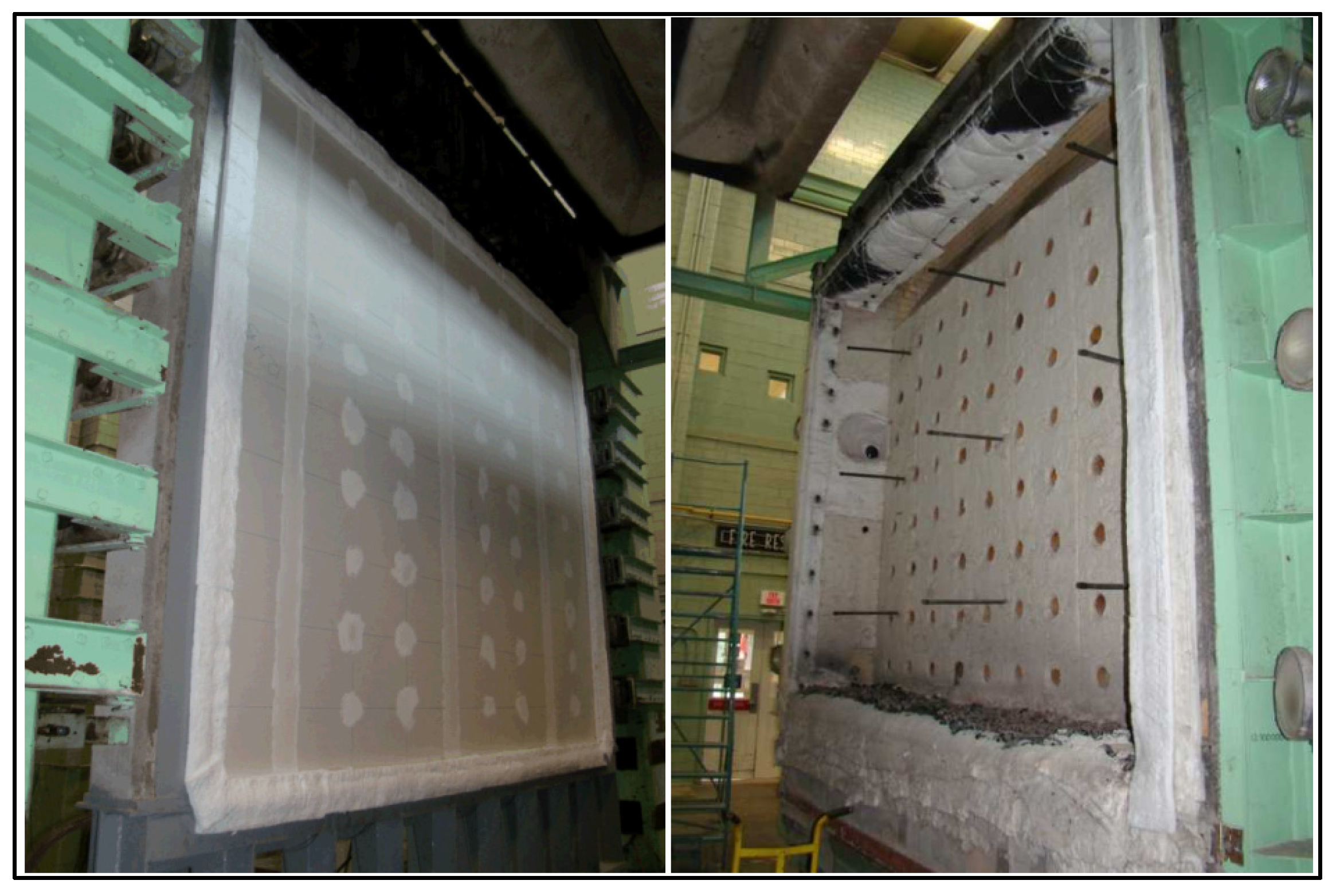
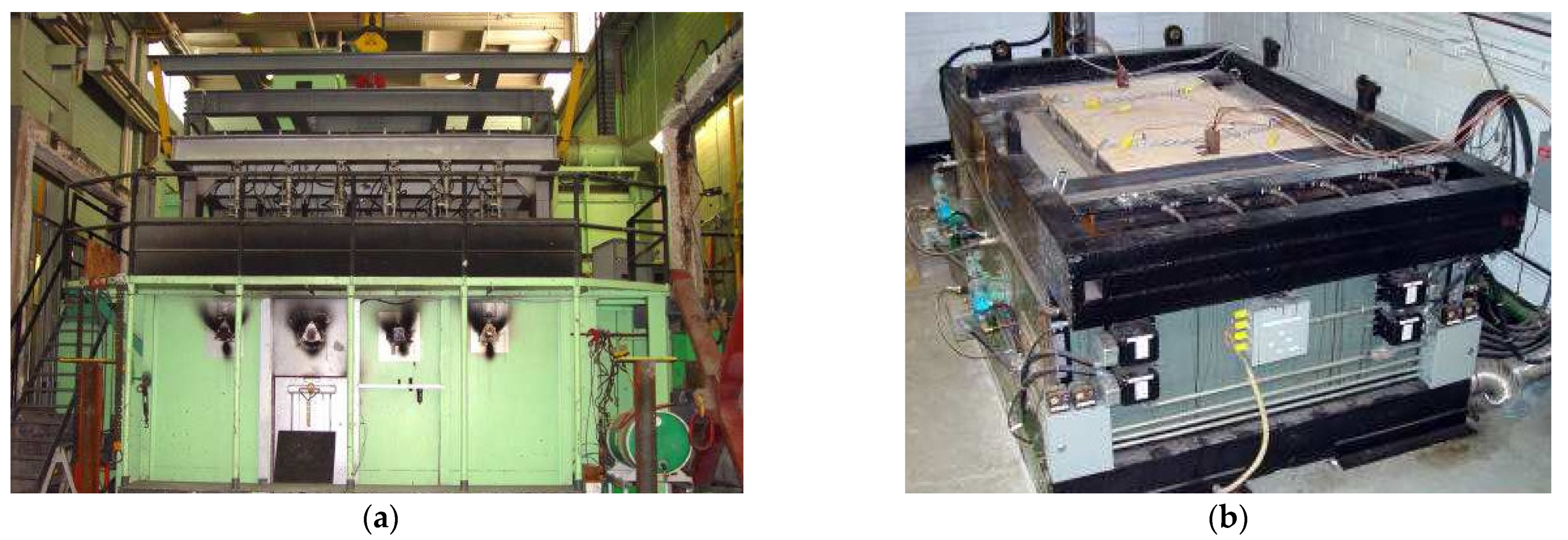
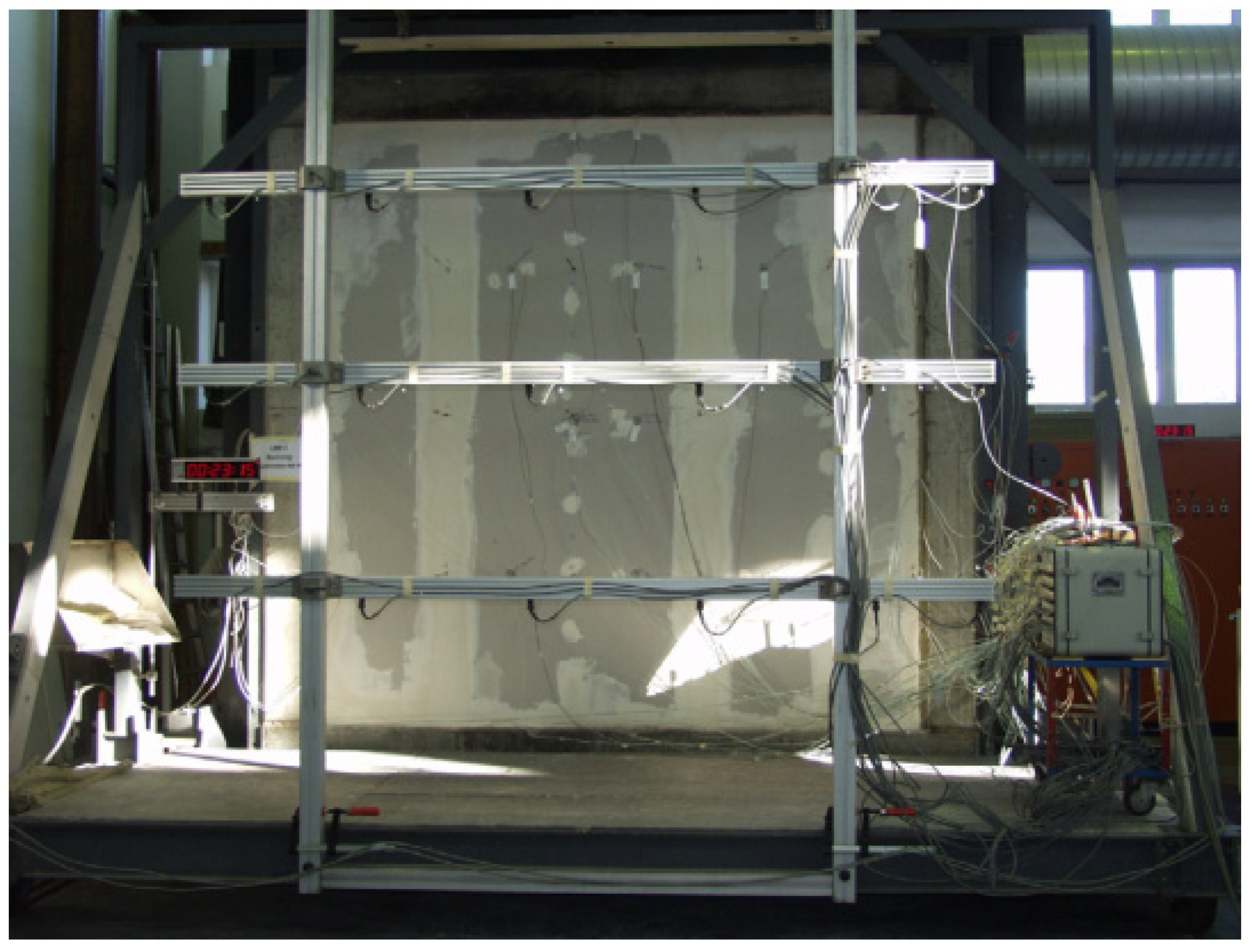
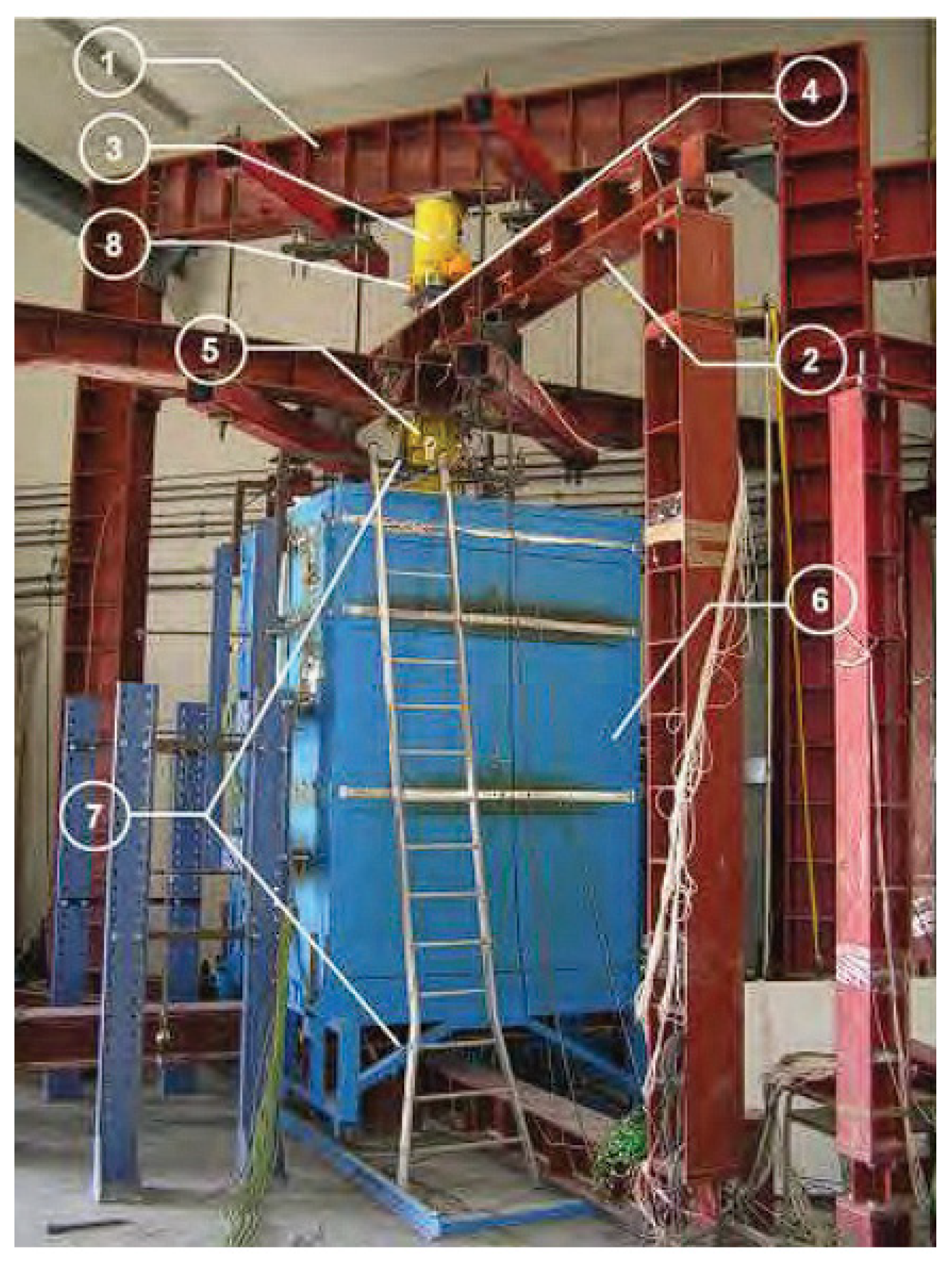

| Year | Development [5,6] |
|---|---|
| 1880 | Start of fire tests in Europe. |
| 1884 | Establish fire-test facility in Berlin and fire tests of columns in Germany and Austria. |
| 1890 | Start of fire tests in the US. |
| 1891 | Fire test of the first wall in Germany. |
| 1891 | Floor fire test in St. Louis. |
| 1892 | Door fire test in Berlin. |
| 1893 | Wall fire test in Vienna and fire tests on floors, doors, and windows in Berlin. |
| 1894 | Fire test of the isolated floor in Trenton. |
| 1896 | Start of column fire tests in the US. |
| 1897 | Forming British fire-prevention committee. |
| 1899 | Issue the red books and starting of fire tests for walls and doors in the UK. |
| 1902 | Establish the first facility for fire tests in the US. |
| 1907 | Develop standard tests for fireproof floors. |
| 1909 | Develop standard tests for fireproof walls. |
| 1917 | Start of underwriter testing programs. |
| 1917 | Issue of ASTM C19. |
| 1941 | Issue of ASTM E152152. |
| 1972 | Issue of IS 3809. |
| 1994 | Issue of Japanese standard fire tests. |
| 1999 | Issue of EN 1363 (Parts 3 and 4) and ISO 834 (Part 1). |
| 2000 | Issue of ISO 834 (Parts 4–8) and UNE-EN 1363-2. |
| 2003 | Issue of ISO 834 (Part 9). |
| 2005 | Issue of AS 1530 (Part 4). |
| 2008 | Issue of GB/T 9978 (Parts 1, 3–9). |
| 2012 | Issue of EN 1363 (Part 1) and EN 1365 (Part 1). |
| 2014 | Issue of EN 1364 (Parts 3 and 4) and EN 1365 (Part 2). |
| 2015 | Issue of EN 1364 (Part 1). |
| 2018 | Issue of EN 1364 (Part 2). |
| 2019 | Issue of GB/T 9978.2. |
| 2020 | Issue of EN 1363-1 2020 (Main) (Replaces EN 1363:1 2012). |
| Standard | Objective |
|---|---|
| BS 476-20 | The test describes general principles for the measurement of fire resistance of building structures. |
| GB/T 9978.1 | General requirements for fire-resistance tests of building elements. |
| GB/T 9978.6 | It describes the requirements for fire-resistance tests on beam. |
| GB/T 9978.7 | Requirements for fire-resistance tests of columns. |
| DIN 4102-2 | Concepts and requirements for building components for fire testing. |
| EN 1363: Part 1 | The test describes the general requirements for fire-resistance test. |
| ISO 834: Part 1 | General principles regarding equipment, instrumentation, and procedures. |
| ISO 834: Part 6 | This test describes certain requisite for beams. |
| ISO 834: Part 7 | This test describes certain requisite for columns. |
| Standard | Objective |
|---|---|
| BS 476-21 | This test describes a fire-resistance test for load-bearing construction materials. |
| GB/T 9978.4 | This test describes a fire-resistance test for load-bearing vertical elements. |
| GB/T 9978.5 | This test describes a fire-resistance test for load-bearing horizontal elements. |
| EN 1365: Part 1 | This test describes a fire-resistance test for load-bearing walls. |
| EN 1365: Part 2 | This test describes a fire-resistance test for load-bearing floor and roof. |
| EN 1365: Part 3 | This test describes a fire-resistance test for load-bearing beams. |
| EN 1365: Part 4 | This test describes a fire-resistance test for the load-bearing column. |
| ISO 834: Part 4 | This test describes a certain requisite for load-bearing vertical separating elements. |
| ISO 834: Part 5 | This test describes a certain requisite for load-bearing horizontal separating elements. |
| Standard | Objective |
|---|---|
| BS 476-22 | This test describes a fire-resistance test for non-load-bearing construction elements. |
| GB/T 9978.8 | This test describes a certain requisite for non-load-bearing vertical elements during fire-resistance tests. |
| GB/T 9978.9 | This test describes a certain requisite for non-load-bearing ceiling elements during fire-resistance tests. |
| EN 1364: Part 1 | This test describes a fire-resistance test for non-load-bearing walls. |
| EN 1364: Part 2 | This test describes a fire-resistance test for non-load-bearing ceilings. |
| EN 1364: Part 3 | Fire-resistance test of non-load-bearing completely assembled curtain walls. |
| EN 1364: Part 4 | This test describes a fire-resistance test of parts of non-load-bearing curtain wall. |
| ISO 834: Part 8 | This test describes certain requisite for non-load-bearing vertical separating elements. |
| ISO 834: Part 9 | This test describes certain requisite for non-load-bearing ceiling elements. |
| Standard | Objective |
|---|---|
| BS 476-23 | This test evaluates the contribution of building components to the fire resistance of a structure. |
| GB/T 7633 | This test evaluates the fire resistance of door and shutters. |
| GB/T 12513 | This test evaluates the fire resistance of glazed elements. |
| GB/T 24573 | This test evaluates the fire resistance of coffers and Archive’s door. |
| GB 12955 | This test evaluates the fire resistance of fire doors. |
| GB 14102 | This test evaluates the fire resistance of fire-resistant shutters. |
| GB 15763.1 | This test evaluates the fire resistance of fire-resistant glass. |
| GB 16809 | This test evaluates the fire resistance of steel fire windows. |
| GB 16807 | This test evaluates the fire resistance of fire intumescent seals. |
| GB 23864 | This test evaluates the fire resistance of firestop materials. |
| DIN 4102-1 | Classification of building materials for fire performance of construction materials. |
| DIN 4102-4 | Overview and design of elements, materials, and components under fire exposure. |
| DIN 4102-8 | Small-scale furnace for fire testing of construction materials and elements. |
| DIN 4102-14 | A radiant heat source used to determine the behavior of floor covering system. |
| DIN 4102-15 | ‘Brandschacht’ apparatus for fire behavior of construction materials and elements. |
| DIN 4102-16 | ‘Brandschacht’ tests for fire behavior of construction materials and elements. |
| Scheme 119. | Wall and Partitions | Floor and Flat Roofs | Columns | Beams | Suspended Celling |
|---|---|---|---|---|---|
| ASTM E119 | Exposure Area ≥ 9 m2 Height ≥ 2.7 m | Exposure Area ≥ 16 m2 Length ≥ 3.7 m | Height ≥ 2.7 m | Length ≥ 3.7 m | Exposure Area ≥ 16 m2 Length ≥ 3.7 m |
| AS 1530 | Exposure Area = 3.0 × 3.0 m2 | Exposure Area = 4.0 × 3.0 m2 | Height ≥ 3.0 m | Length ≥ 3.0 m | Exposure Area = 4.0 × 3.0 m2 |
| BS 476, DIN 4102, EN 1363, ISO 834 | Width = 3.5 m Height = 2.5 m | Width = 2.5 m Span = 4.0 m | Height ≥ 3.0 m | Length ≥ 4.0 m | Exposure Area ≥ 10 m2 |
| IS 3809 | Width = 3.0 m Height = 3.0 m | Width = 2.0 m Span = 4.0 m | Height = 3.0 m | Length = 4.0 m | NA |
| JIS A 1304 | Height = 2.4 m Width = 1.8 m | Length = 2.4 m Width = 1.8 m | Height = 2.4 m | Length = 2.4 m | NA |
| Standard | Wall and Partitions | Floor and Flat Roofs | Columns | Beams | Suspended Celling |
|---|---|---|---|---|---|
| ASTM E119 | One side | Underside | Four sides | Four sides | Underside |
| BS 476 EN 1363 | One side | Underside | Four sides | Four sides | Underside |
| IS 3809 | One side | Underside | Four sides | Three sides | Underside |
| ISO 834 | One side | Underside | Four sides | Three or four sides | Underside |
| S. No. | Non-Standard Fire-Resistance Test of Real Fires in Real Buildings | Institute that Performed Tests |
|---|---|---|
| 1 | Test conducted to evaluate the broad behavior composite frame structures of steel concrete and validating FASBUS II (a computer model) for structural resistance to fire. | National Building Standards and American Iron and Steel Institute |
| 2 | Test performed on water-and-concrete-filled columns with composite steel concrete structure. Timber cribs used for fire exposure. | Stuttgart-Vaihingen University, Germany, |
| 3 | Test conducted on a compartment of steel concrete composite frame (size 4 × 4 m). Office furniture was used for fire exposure. This test established the use of a sprinkler system to avoid collapse. | William Street Australia |
| 4 | Test performed on steel concrete composite frame (size 8.4 × 3.6 m). office furniture was used for fire exposure. | Collins Street Test |
| 5 | Six different structural fire tests conducted on eight-story steel concrete composite frame. Test-1: Gas furnace used for fire exposure on restrained floor beam of specimen (size 9 m). This test measured the tensile failure of connections at the time of cooling. Test-2: Gas furnace used for fire exposure on long pane frame of 21 m. The test reported the local buckling and shear breakdown of bolts during cooling. Test-3: Timber cribs used for fire exposure on floor compartment (size 9 × 6 m). Membrane action and load path changes were measured in this test. Test-4: Timber cribs used for fire exposure on floor compartment (size 9 × 6 m). Interaction between non-exposed and exposed structures were reported. Test-5: Timber cribs used for fire exposure on large section (size 18 × 21 m); connection failure was observed during cooling. Test-6: Office furniture was used for fire exposure on a floor section (size 162 m2). Steel lattice lap fault during structure; cracking around columns established during cooling. | BRE Cardington Steel Building Tests |
| 6 | The test reported the membrane actions of unprotected composite steel concrete frame (size 16 × 32 m) when it exposed to the fire resulted from burning of 3 cars in a closed parking space. | Car Park Fire Tests |
| 7 | The comprehensive behavior was reported for timber frame structure of compartment (size 24.1 × 12.4 m) when it was exposed to fire initiated by timber cribs. The author also reported the fire potentially spread to the connecting compartment. | Cardington, United Kingdom |
| 8 | The test reported the membrane action and spalling of floor size (2 × 2 bays, 225 m2) when exposed to fire initiated by timber cribs. | Cardington, United Kingdom |
| 9 | The test reported the development of fire, burning and cooling stages in concrete frame structure (size 12 × 12 m) when exposed to fire initiated by timber/plastic cribs. | Cardington, United Kingdom |
| 10 | The test reported the effect of fire (initiated by timber cribs) on a large section of a composite structure (size 11 × 7 m). The structure was loaded to 56% of its room-temperature capacity. Cracks were observed at column heads. | Czech Technical University, Cardington, United Kingdom |
| 11 | The test was performed on a structure (size 3.8 × 6 m) with a fire initiated by timber cribs. The test reported the gas and steel temperature irrespective of structural damage. | CTU, Ostrava, Czech Republic |
| 12 | The test reported the tensile cracking and connection breakdown at time of cooling when composite frame (size 2 × 3.6 × 3.6 m) bays exposed to fire generated by four oil fired burners. | Harbin Institute of Technology |
| 13 | The test reported the behavior of properly designed and detailed building when exposed under the fire initiated by timber cribs. | BRE, United Kingdom |
| 14 | The test reported the behavior of structure associated with different components (size 12 × 18 m) when exposed to fire initiated by timber cribs. The test reported the several local failure modes, using a variation of composition. | CTU, Mokrsko, Czech Republic |
| 15 | The test reported the insulation integrity failure because of improper mesh lapping of structure if experience to fire initiated at the corner of building compartment. A gas furnace was used for the test. | FRACOF, Metz, France |
| 16 | The test reported the flexural breakdown of beam when exposed to the fire initiated at the corner of the building compartment. | COSSFIRE, Metz, France |
| 17 | The test reported the spalling and associated protection of concrete columns when exposed to the fire initiated by ethanol pool fire. | Hong Kong Polytechnic University, China |
| 18 | The test reported the spalling in columns when exposed to fire developed by timber cribs, along with a few structural design aspects related to polypropylene fibers. | CCAA-CESARE, Australia |
| 19 | The test performed to measure the membrane action on a concrete steel composite frame (sized 15 × 9 m) when exposed under the timber cribs fire. | University of Ulster, United Kingdom |
| 20 | The test conducted on concrete steel composite (size 5 × 12.5 m). Insufficient information is available to describe testing procedure of this test. | TU, Munich, Germany |
| 21 | The test reported the behavior of reinforced concrete frame support when experienced to fire initiated by gas burner and also reported the advantages of using polypropylene fiber to reduce spalling in structural development. | TU, Vienna, Austria |
| 22 | The test reported the kerosene pool fire effect on post-earthquake reinforced-concrete structure (size 9 × 12 m). | University of Edinburgh/IIT Roorkee, India |
Disclaimer/Publisher’s Note: The statements, opinions and data contained in all publications are solely those of the individual author(s) and contributor(s) and not of MDPI and/or the editor(s). MDPI and/or the editor(s) disclaim responsibility for any injury to people or property resulting from any ideas, methods, instructions or products referred to in the content. |
© 2022 by the authors. Licensee MDPI, Basel, Switzerland. This article is an open access article distributed under the terms and conditions of the Creative Commons Attribution (CC BY) license (https://creativecommons.org/licenses/by/4.0/).
Share and Cite
Chaturvedi, S.; Vedrtnam, A.; Youssef, M.A.; Palou, M.T.; Barluenga, G.; Kalauni, K. Fire-Resistance Testing Procedures for Construction Elements—A Review. Fire 2023, 6, 5. https://doi.org/10.3390/fire6010005
Chaturvedi S, Vedrtnam A, Youssef MA, Palou MT, Barluenga G, Kalauni K. Fire-Resistance Testing Procedures for Construction Elements—A Review. Fire. 2023; 6(1):5. https://doi.org/10.3390/fire6010005
Chicago/Turabian StyleChaturvedi, Shashikant, Ajitanshu Vedrtnam, Maged A. Youssef, Martin T. Palou, Gonzalo Barluenga, and Kishor Kalauni. 2023. "Fire-Resistance Testing Procedures for Construction Elements—A Review" Fire 6, no. 1: 5. https://doi.org/10.3390/fire6010005







